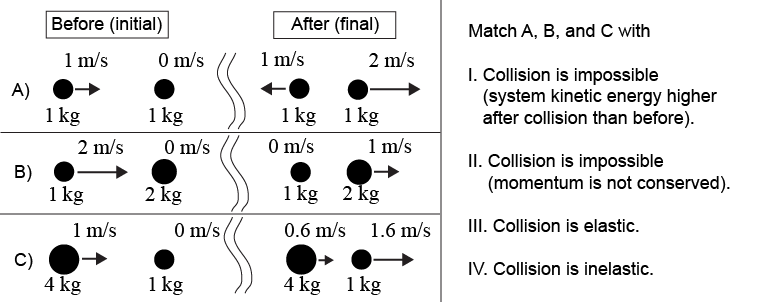|
There are two basic categories of collisions, elastic and inelastic. Momentum is conserved in both types of collisions. Kinetic energy, however, is conserved only in elastic collisions. Kinetic energy isn’t really lost during inelastic collisions; it is converted into other forms of energy, such as thermal energy or sound. In a perfectly inelastic collision, the colliding objects stick together and move as a single body. 
|
|
collision, inelastic collision, elastic collision
|
|
|
| | |
|
|
Review problems and questions |
|
- Rudolf is traveling at 3.0 m/s in his toy bumper car when he has a rear-end collision with Marcel, whose bumper car is initially at rest. The mass of each boy and his bumper car is 100 kg. As a result of the collision, Marcel glides off at 3.0 m/s in the direction that Rudolf had been going.
- What is Rudolf’s velocity after the collision?
- Is the collision elastic or inelastic?

 |
Answer: - Rudolf’s final velocity is zero. Rudolf comes to a complete stop.
- The collision is elastic.
Solution: - First, let’s apply the law of conservation of momentum to the Rudolf–Marcel system. Assume that Rudolf initially moved in the positive (+x) direction. Let’s use this information to compute the system’s total initial momentum: The law of conservation of momentum says that the final system momentum must also equal this value. We know Marcel’s mass and final velocity, so we insert those into the formula for the final system momentum. Then we solve for Rudolf’s final velocity, vRf : Now equate the final and initial momenta to solve for Rudolf’s final velocity: Since the total final momentum must equal +300 kg m/s, Rudolf’s final velocity must be zero. Rudolf comes to a complete stop.
- To determine whether the collision is elastic or inelastic, we must compute the total kinetic energy both before and after the collision. If the kinetic energy remains unchanged, the collision is elastic. Otherwise, the collision is inelastic (with some of the kinetic energy being transformed into heat, sound, or yet another form).
First, let’s calculate the system’s initial kinetic energy: The system’s final kinetic energy is: The kinetic energy remains unchanged at 450 J, and therefore the collision is elastic. (You could determine this without calculating. Note that one 100 kg car moves at 3 m/s and the other is motionless—both before and after the collision.) 
|
- A collision takes place on a hockey rink. Sonja (m = 80 kg) slides into Yoon-Hee (m = 60 kg), who is initially at rest. Sonja skates into Yoon-Hee at 3 m/s, and as a result Yoon-Hee is ejected with the same velocity, in the direction that Sonja had been going.
- What is Sonja’s velocity after the collision?
- Is the collision elastic or inelastic?

 |
Answer: - +0.75 m/s
- The collision is inelastic.
Solution: - Let’s apply the law of conservation of momentum to the Sonja−Yoon-Hee system. Assume that Sonja initially moved in the positive (+x) direction. The system’s initial momentum is therefore The law of conservation of momentum says that the final system momentum must also equal this value. We know Yoon-Hee’s mass and final velocity, so we insert those into the formula for the final system momentum. Then we solve for Sonja’s final velocity, vSf : Equate the initial and final momenta to solve for Yoon-Hee’s final velocity: In this case, Yoon-Hee’s mass is less than Sonja’s. Since Yoon-Hee’s velocity after the collision is the same as Sonja’s was beforehand, some positive momentum must remain with Sonja. In other words, Sonja remains in motion, though at a slower speed.
- To determine whether the collision is elastic or inelastic, we must compute the total kinetic energy both before and after the collision. If the kinetic energy remains unchanged, the collision is elastic. Otherwise, the collision is inelastic. Before the collision we have After the collision we have The system’s total kinetic energy is reduced by the collision because 292.5 J is less than 360 J. The collision is therefore inelastic.

|

- The graphic above shows three collision scenarios (A, B, and C). Each collision is between two objects that only can move horizontally. Match each scenario with one of the numbered statements (I, II, III, or IV).

 |
 Answer:
Answer:
Scenario A: I.
Scenario B: IV.
Scenario C: III.
To answer this question, we must calculate four quantities for each scenario (A, B, and C). The quantities are: - the total momentum before collision: (pi1 + pi2)
- the total momentum after collision: (pf1 + pf2)
- the total kinetic energy before collision: (KEi1 + KEi2)
- the total momentum after collision: (KEf1 + KEf2)
Then we can classify each collision using the decision tree shown to the right. Let’s recall the necessary formulas: Scenario A:
First, check whether the final kinetic energy is too large: - object 1, before: Ek = ½(1 kg)(1 m/s)2 = 0.5 J
- object 2, before: Ek = ½(1 kg)(0 m/s)2 = 0 J
- total Ek, before: 0.5 J + 0 J = 0.5 J
- object 1, after: Ek = ½(1 kg)(1 m/s)2 = 0.5 J
- object 2, after: Ek = ½(1 kg)(2 m/s)2 = 2 J
- total Ek, after: 0.5 J + 2 J = 2.5 J
In Scenario A, the system’s kinetic energy is larger after the collision than it was before. This violates the conservation of energy and thus is impossible. Therefore, choice I is correct.
Scenario B:
First, check whether the final kinetic energy is too large: - object 1, before: Ek = ½(1 kg)(2 m/s)2 = 2 J
- object 2, before: Ek = ½(2 kg)(0 m/s)2 = 0 J
- total Ek, before: 2 J + 0 J = 2 J
- object 1, after: Ek = ½(1 kg)(0 m/s)2 = 0 J
- object 2, after: Ek = ½(2 kg)(1 m/s)2 = 1 J
- total Ek, after: 0 J + 1 J = 1 J
In Scenario B, the final total kinetic energy is smaller than the initial value. Thus conservation of energy is not violated. Now let’s check whether momentum is conserved: - object 1, before: p = (1 kg)(+2 m/s) = +2 kg m/s
- object 2, before: p = (2 kg)(0 m/s) = 0 kg m/s
- total p, before: +2 kg m/s + 0 kg m/s = +2 kg m/s
- object 1, after: p = (1 kg)(0 m/s) = 0 kg m/s
- object 2, after: p = (2 kg)(+1 m/s) = +2 kg m/s
- total p, after: 0 kg m/s + 2 kg m/s = +2 kg m/s
In Scenario B, momentum is conserved. Therefore this is a permissible collision! The last thing we have to determine is whether it is an elastic or inelastic collision. Looking above, we see that the final kinetic energy is smaller than the initial kinetic energy. The collision is therefore inelastic. The correct answer is therefore choice IV.
Scenario C: Again, let’s start by checking whether the final kinetic energy is too large: - object 1, before: Ek = ½(4 kg)(1 m/s)2 = 2 J
- object 2, before: Ek = ½(1 kg)(0 m/s)2 = 0 J
- total Ek, before: 2 J + 0 J = 2 J
- object 1, after: Ek = ½(4 kg)(0.6 m/s)2 = 0.72 J
- object 2, after: Ek = ½(1 kg)(1.6 m/s)2 = 1.28 J
- total Ek, after: 0.72 J + 1.28 J = 2 J
The system’s final kinetic energy equals the initial value. Is momentum also conserved? - object 1, before: p = (4 kg)(+1 m/s) = +4 kg m/s
- object 2, before: p = (1 kg)(0 m/s) = 0 kg m/s
- total p, before: 4 kg m/s + 0 kg m/s = +4 kg m/s
- object 1, after: p = (4 kg)(+0.6 m/s) = +2.4 kg m/s
- object 2, after: p = (1 kg)(+1.6 m/s) = +1.6 kg m/s
- total p, after: +2.4 kg m/s + 1.6 kg m/s = +4 kg m/s
Momentum is conserved in Scenario C and since kinetic energy is, too, the collision is elastic. The correct answer is therefore choice III. 
|
Take a Quiz |
| |
|

